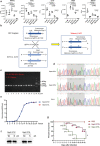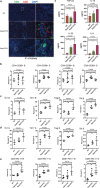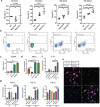Sequence Variation of Candida albicans Sap2 Enhances Fungal Pathogenicity via Complement Evasion and Macrophage M2-Like Phenotype Induction
- PMID: 37211685
- PMCID: PMC10369283
- DOI: 10.1002/advs.202206713
Sequence Variation of Candida albicans Sap2 Enhances Fungal Pathogenicity via Complement Evasion and Macrophage M2-Like Phenotype Induction
Abstract
Candida albicans (C. albicans) is an opportunistic pathogen increasingly causing candidiasis worldwide. This study aims to investigate the pattern of systemic immune responses triggered by C. albicans with disease associated variation of Sap2, identifying the novel evasion strategies utilized by clinical isolates. Specifically, a variation in clinical isolates is identified at nucleotide position 817 (G to T). This homozygous variation causes the 273rd amino acid exchange from valine to leucine, close to the proteolytic activation center of Sap2. The mutant (Sap2-273L) generated from SC5314 (Sap2-273V) background carrying the V273L variation within Sap2 displays higher pathogenicity. In comparison to mice infected with Sap2-273V strain, mice infected with Sap2-273L exhibit less complement activation indicated by less serum C3a generation and weaker C3b deposition in the kidney. This inhibitory effect is mainly achieved by Sap2273L -mediated stronger degradation of C3 and C3b. Furthermore, mice infected with Sap2-273L strain exhibit more macrophage phenotype switching from M0 to M2-like and more TGF-β release which further influences T cell responses, generating an immunosuppressed cellular microenvironment characterized by more Tregs and exhausted T cell formation. In summary, the disease-associated sequence variation of Sap2 enhances pathogenicity by complement evasion and M2-like phenotype switching, promoting a more efficient immunosuppressed microenvironment.
Keywords: Candida albicans; complement evasion; fungal pathogenicity; immunosuppressed cellular environment; sequence variation.
© 2023 The Authors. Advanced Science published by Wiley-VCH GmbH.
Conflict of interest statement
The authors declare no conflict of interest.
Figures







Similar articles
-
Sequence variations and protein expression levels of the two immune evasion proteins Gpm1 and Pra1 influence virulence of clinical Candida albicans isolates.PLoS One. 2015 Feb 18;10(2):e0113192. doi: 10.1371/journal.pone.0113192. eCollection 2015. PLoS One. 2015. PMID: 25692293 Free PMC article.
-
Host versus in vitro signals and intrastrain allelic differences in the expression of a Candida albicans virulence gene.Mol Microbiol. 2002 Jun;44(5):1351-66. doi: 10.1046/j.1365-2958.2002.02967.x. Mol Microbiol. 2002. PMID: 12028383
-
Secreted aspartic protease 2 of Candida albicans inactivates factor H and the macrophage factor H-receptors CR3 (CD11b/CD18) and CR4 (CD11c/CD18).Immunol Lett. 2015 Nov;168(1):13-21. doi: 10.1016/j.imlet.2015.08.009. Epub 2015 Aug 22. Immunol Lett. 2015. PMID: 26306739
-
Candida and candidiasis in HIV-infected patients: where commensalism, opportunistic behavior and frank pathogenicity lose their borders.AIDS. 2012 Jul 31;26(12):1457-72. doi: 10.1097/QAD.0b013e3283536ba8. AIDS. 2012. PMID: 22472853 Review.
-
[What functions do six different genes for secretory proteinases have in Candida albicans?].Mycoses. 1998;41 Suppl 1:47-50. doi: 10.1111/j.1439-0507.1998.tb00583.x. Mycoses. 1998. PMID: 9717386 Review. German.
Cited by
-
Candida albicans Biofilm-Derived Extracellular Vesicles Are Involved in the Tolerance to Caspofungin, Biofilm Detachment, and Fungal Proteolytic Activity.J Fungi (Basel). 2023 Nov 4;9(11):1078. doi: 10.3390/jof9111078. J Fungi (Basel). 2023. PMID: 37998883 Free PMC article.
-
The OsAP4-OsCATA/OsCATC Regulatory Module Orchestrates Drought Stress Adaptation in Rice Seedlings Through ROS Scavenging.Plants (Basel). 2025 Jul 14;14(14):2174. doi: 10.3390/plants14142174. Plants (Basel). 2025. PMID: 40733410 Free PMC article.
-
Candidiasis: Insights into Virulence Factors, Complement Evasion and Antifungal Drug Resistance.Microorganisms. 2025 Jan 25;13(2):272. doi: 10.3390/microorganisms13020272. Microorganisms. 2025. PMID: 40005639 Free PMC article. Review.
-
Secreted Aspartic Proteinases: Key Factors in Candida Infections and Host-Pathogen Interactions.Int J Mol Sci. 2024 Apr 27;25(9):4775. doi: 10.3390/ijms25094775. Int J Mol Sci. 2024. PMID: 38731993 Free PMC article. Review.
-
Immunosuppressive microvesicles-mimetic derived from tolerant dendritic cells to target T-lymphocytes for inflammation diseases therapy.J Nanobiotechnology. 2024 Apr 24;22(1):201. doi: 10.1186/s12951-024-02470-z. J Nanobiotechnology. 2024. PMID: 38659058 Free PMC article.
References
-
- a) Hirakawa M. P., Martinez D. A., Sakthikumar S., Anderson M. Z., Berlin A., Gujja S., Zeng Q., Zisson E., Wang J. M., Greenberg J. M., Berman J., Bennett R. J., Cuomo C. A., Genome Res. 2015, 25, 413; - PMC - PubMed
- b) Zhang C., Wang W., Kong Q., Liu F., Chen J., Sang H., Mycologia 2019, 111, 942; - PubMed
- c) Sanglard D., Ischer F., Calabrese D., Micheli M., Bille J., Drug Resistance Updates 1998, 1, 255. - PubMed
-
- a) Alonso‐Valle H., Acha O., García‐Palomo J. D., Fariñas‐Alvarez C., Fernández‐Mazarrasa C., Fariñas M. C., Eur. J. Clin. Microbiol. Infect. Dis. 2003, 22, 254; - PubMed
- b) Gudlaugsson O., Gillespie S., Lee K., Berg J. V., Hu J., Messer S., Herwaldt L., Pfaller M., Diekema D., Clin. Infect. Dis. 2003, 37, 1172; - PubMed
- c) Pappas P. G., Rex J. H., Lee J., Hamill R. J., Larsen R. A., Powderly W., Kauffman C. A., Hyslop N., Mangino J. E., Chapman S., Horowitz H. W., Edwards J. E., Dismukes W. E., Clin. Infect. Dis. 2003, 37, 634. - PubMed
-
- a) Bacher P., Hohnstein T., Beerbaum E., Röcker M., Blango M. G., Kaufmann S., Röhmel J., Eschenhagen P., Grehn C., Seidel K., Rickerts V., Lozza L., Stervbo U., Nienen M., Babel N., Milleck J., Assenmacher M., Cornely O. A., Ziegler M., Wisplinghoff H., Heine G., Worm M., Siegmund B., Maul J., Creutz P., Tabeling C., Ruwwe‐Glösenkamp C., Sander L. E., Knosalla C., Brunke S., et al., Cell 2019, 176, 1340; - PubMed
- b) Chen J., He R., Sun W., Gao R., Peng Q., Zhu L., Du Y., Ma X., Guo X., Zhang H., Tan C., Wang J., Zhang W., Weng X., Man J., Bauer H., Wang Q. K., Martin B. N., Zhang C. J., Li X., Wang C., Nat. Commun. 2020, 11, 1913. - PMC - PubMed
Publication types
MeSH terms
Substances
Grants and funding
LinkOut - more resources
Full Text Sources
Miscellaneous
